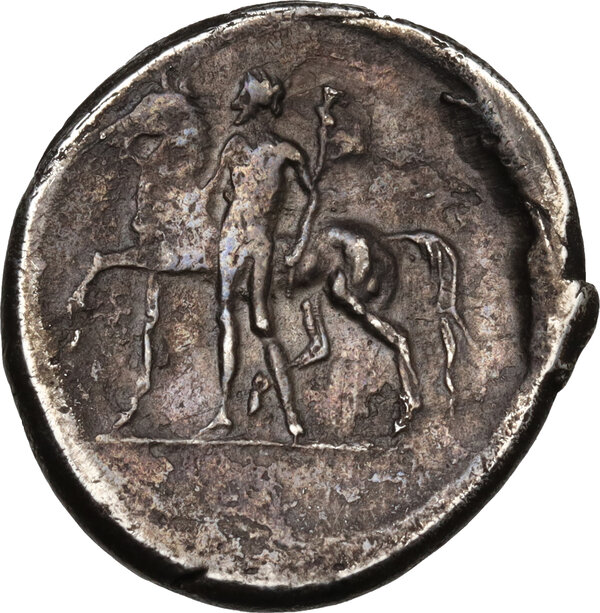

Lotto 43:
Greek Italy. Central and Southern Campania, Nuceria Alfaterna. AR Didrachm, c. 250-225 BC. Obv. Head of Carneius left, ram's horn in hair; behind, triskeles; Oscan legend 'nukrinum alafaternum' around. Rev. Dioskouros standing left beside horse, holding reins and spear. HN Italy 608; SNG ANS 560 var.(dolphin instead of triskeles on obv.). 7.02 g. 23.00 mm. RR. Very rare. Dark surfaces. About VF/Good F. Around the end of the seventh century BC, inhabitants of the Sarno Valley founded a new city in a strategic location between the gulfs of Naples and Salerno. Created from the synoecism (union) of several scattered villages, the new city was named Nuvkrinum (literally 'new fortress'), and was situated astride the obligatory route between the aforementioned coastal areas, guarding a fertile valley. The city thus became one of the twelve most important centres of Etruscan colonisation in Campania created to stop the northward expansion of the Greeks.
After the defeat of the Etruscan navy at the Battle of Cumae in 474 BC the Etruscans abandoned the region, and the city came into the possession of the Samnites who renamed it Nuvkrinvm Alfaternum, after the Samnite Alfaterni tribe.
Hostile to the Romans during the Second Samnite War, in 308 BC it repulsed a Roman attempt to land at the mouth of the Sarnus, but in 307 BC it was besieged and surrendered. In defeat it became an ally of Rome and remained loyal during the war against Hannibal, for which loyalty it suffered greatly, being razed to the ground. The present coin dates to a period of prosperity between the two wars, and represents the only silver issue of this city.
(Roma Numismatics 13,2017, 24 note).
After the defeat of the Etruscan navy at the Battle of Cumae in 474 BC the Etruscans abandoned the region, and the city came into the possession of the Samnites who renamed it Nuvkrinvm Alfaternum, after the Samnite Alfaterni tribe.
Hostile to the Romans during the Second Samnite War, in 308 BC it repulsed a Roman attempt to land at the mouth of the Sarnus, but in 307 BC it was besieged and surrendered. In defeat it became an ally of Rome and remained loyal during the war against Hannibal, for which loyalty it suffered greatly, being razed to the ground. The present coin dates to a period of prosperity between the two wars, and represents the only silver issue of this city.
(Roma Numismatics 13,2017, 24 note).
Base d'asta € 200
Prezzo attuale € 340
Offerte: 9
Lotto non in vendita
Prezzo attuale € 340
Offerte: 9
Lotto non in vendita





